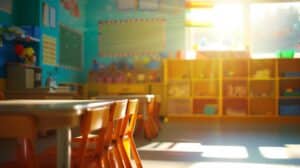
The term physical environment refers to the overall design and layout of a given classroom and its learning centers. Special education teachers should design the environment by organizing its spaces, furnishings, and materials to maximize the learning opportunities, accessibility, and the engagement of every student. Put simply, an intentionally designed classroom is essential to establishing a supportive learning community where students feel safe, valued, and ready to learn.
The first step in creating a physical environment that works for you is to ensure that you have created specific learning areas in your classroom for the different types of instruction that takes place during the day. For example:
These spaces should be clearly defined with appropriate boundaries to designate each area and the expected behaviors within them. When you create these work spaces in your classroom, you will have to teach – and your paras will have to model – those expected behaviors during instruction. To support this, it is important that your physical environment and your schedule are cohesive and interchangeable regardless of what the day throws at you.
Most of us think of schedules as pertaining to the instructional time in our day. However, we all know that your classroom is a revolving door of related-service providers, support staff, feeding and bathroom expectations.
Your schedule is not limited to just your students but anyone and everyone who engages with your classroom. It should always include a visual representation of where your students are throughout the day, who they are working with, and when they will be pulled for related services. The schedule should also include a time component to indicate the start and end time for each activity. This creates predictability, which leads to skill acquisition and tolerance for change. You, as the instructional leader, are continuously modeling how to be flexible within a predictable schedule that may have unpredictable elements throughout the day.
Once you’ve designed your physical environment and created your schedules, the next step is to consider the materials you will use to support skill acquisition. It is important to consider the needs of each student in the classroom. What is beneficial for one, may be aversive for another. The term ‘materials,’ like with schedules, is all-encompassing. It includes, but is not limited to:
When the materials you offer meet the needs of your students, you provide them with multiple means of accessing grade-aligned content that fosters independence, recruits engagement during instruction, and promotes success towards IEP goals and mastery of content. It doesn’t end there. A byproduct of providing appropriate materials allows space for the development of social and emotional skills.
Within TeachTown’s K-12 standards-based, adapted core curriculum, enCORE, you have differentiated lesson plans and materials that allow you to modify instruction to best support each student in the classroom. With that box checked, you have the opportunity to cultivate a classroom environment that is appropriately designed, contains the supports needed for day-to-day routines, and the materials required for engagement. All of these factors build on the abilities and skills of each student, enabling them to grow at their pace while also meeting the demands of district, state, and federal law.
enCORE, and the full suite of solutions at TeachTown, not only empowers students, but empowers educators to do and be better every day. All of the resources for instruction and interventions are available at their fingertips as a one-stop shop, giving much-needed time back to focus on the structures that nurtures teaching and learning.
Contributor Bios
Rachel Roth McKnight, M.Ed., is a Special Educator who worked in public education for 9 years in Baltimore and Florida before joining the team at TeachTown. Rachel received her Bachelor’s Degree in Liberal Arts from the University of Maryland and her Master’s Degree in Special Education from Towson University in the Teacher as Leader in Autism Spectrum Disorders (TALA) Program. In Baltimore, Rachel helped pilot an inclusion-based program for autistic pre-k and and kindergarten students and it set the stage for a career working with teachers to provide equitable, accessible instruction for all learners. In her free time, Rachel enjoys running, reading, memes, and making up songs with her two sons.
Aletta Nagel, M.S., BCBA, LBA, is a Board Certified Behavior Analyst (BCBA) with a passion for Applied Behavior Analysis (ABA) and special education. She earned her Bachelor’s Degree from Lesley University in Boston, MA, and her Master’s Degree from Florida Institute of Technology in Melbourne, FL. Aletta has dedicated the last decade to working with special needs children, with the last four years working as a BCBA in a clinical, home and school setting. In her free time, she enjoys baking and reading novels.